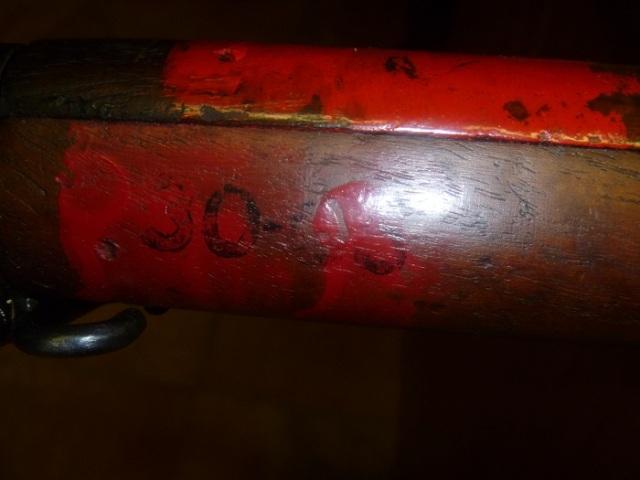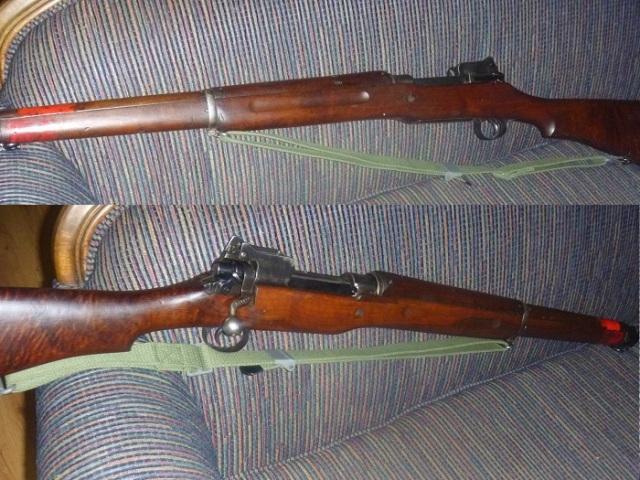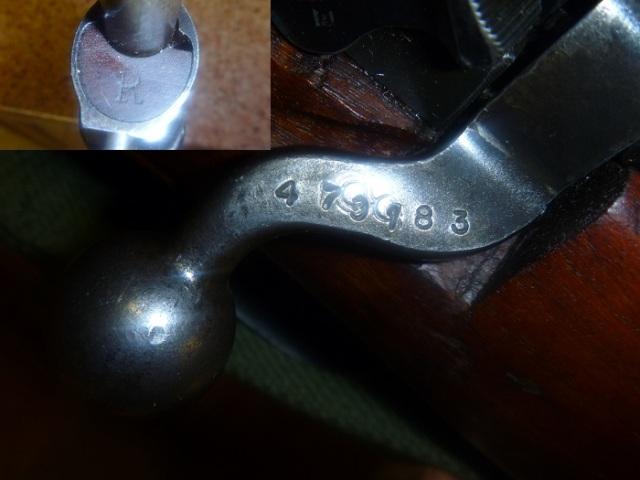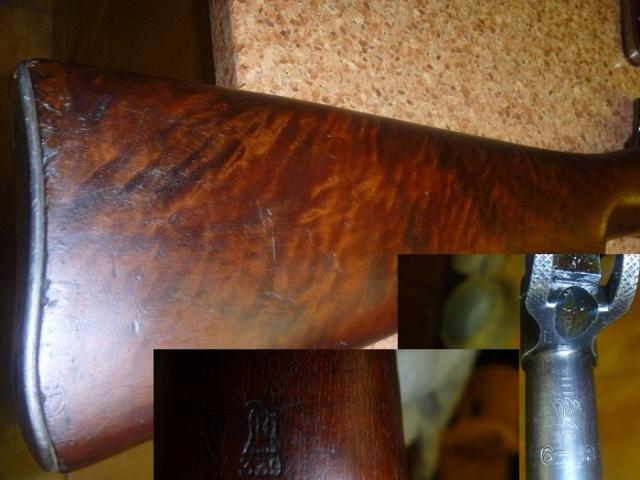-
Legacy Member

I have a theory and ?'s on my Model 1917 quirks.
-
-
03-23-2011 08:27 AM
# ADS
Friends and Sponsors

-
Advisory Panel



Originally Posted by
sakorick

There is the eagle proof 339 cartouche in front of the triggerguard so it went through rebuild....right?
Sorry, that just means that that part came off a rifle that was so treated. The metalwork was not parked at rebuild, because it came off a rifle (or rifles!) that was not rebuilt.
First off: the red stripe on the handguard does not match up with the red stripe on the fore-end.
Secondly: to paint a red paint stripe round the wood, there is no reason to dismantle the rifle.
Ergo I would expect the stripe to match around the wood.
This was the case on every "red-stripe" example" I have seen here in Mauserland. They are plentiful here, and you have to look very closely to find one without any hint of a stripe. The stripes have often been removed by previous owners, so you have to look with an eyeglass to find traces of paint in the pores of the wood.
And why worry about the paint? Because the ones in British hands were apparently handed out to the Home Guard (Dad's Army!), not to serious shooters. They tend to have brilliant bores with blunderbuss muzzles - the result of years being polished to death for inspections, using that well-known crown-killer - a wrongly applied pull-through. So check these aspects most carefully.
hands were apparently handed out to the Home Guard (Dad's Army!), not to serious shooters. They tend to have brilliant bores with blunderbuss muzzles - the result of years being polished to death for inspections, using that well-known crown-killer - a wrongly applied pull-through. So check these aspects most carefully.
My verdict from experience, not armchair theory: that rifle is a mixmaster. Particularly when you consider the bolt system. Although the theory of M1917 specification and fabrication was to have (as far as possible) interchangeable parts, I seriously doubt that this would go as far as mixing up bolt assembly components. Of course, no-one now can say who did this. It could have been an armorer or civilian gunsmith matching up bits to make an excellent shooting rifle. Or (unfortunately, this is more likely) someone scraping out the parts drawer to make something sellable.
After all that negative comment, I would like to say that the wood on the butt looks lovely. If it was mine, I would totally forget the futile "who did what when why" aspects, just accept it as it is, clean off the red stripe, check the crown, muzzle, head clearance etc, and do my best to turn into a beautiful-looking shooter.
Patrick

Last edited by Patrick Chadwick; 03-23-2011 at 09:09 AM.
-
-
-
Legacy Member

Hello Patrick. The red stripe on the top is also a different shade and newer looking. The lower stripe on the stock looks genuine. I think I'll clean off the paint on the handguard and leave the lower paint intact. I have a spare Eddystone bolt that is all matching. Perhaps I will swap it out and check the headspace. Did the Brits add serial numbers to the Remington bolt? I've already checked the muzzle and it gauges under 1.5. I'll check the headspace when my gauge arrives.....the crown looks perfect. Thanks for your input. Regards, Rick.
-
-
Legacy Member

Right after WWI ended Springfield Armory recalled of the M1917's and inspected and re-built as needed all to new/near new condition. Then placed into storage. It was these SA housed M1917's that were shipped off to Britian in 1940. I think SA housed something like 1.2 million M1917's. This particular rifle appears re-built by the Brits during WWII. So that rifle likely was re-built twice. Lots of history these M1917's.
-
-
Legacy Member

Hello Steve. That would sure explain the collection of various parts. I think I'll just leave it alone as is and shoot the thing. Regards, Rick.
-
-
-
Advisory Panel



Originally Posted by
sakorick

Did the Brits add serial numbers to the Remington bolt?
Apparently so. Certainly that bolt has had the number added retrospectively. I think I see a flaming bomb mark under the number on the bolt - have a close look at various angles.
-
-
Legacy Member


Was'nt the red stripe on lend-lease guns put there by the British to indicate non-standard caliber? It looks like 30-06 has been painted over the stripe using black paint. There was a batch of Garands imported a while back that had the stripe with the numbers 30 or 300 on the red to indicate they were .30 cal not .303. I would leave the stripe alone, it's part of the rifles history.
to indicate non-standard caliber? It looks like 30-06 has been painted over the stripe using black paint. There was a batch of Garands imported a while back that had the stripe with the numbers 30 or 300 on the red to indicate they were .30 cal not .303. I would leave the stripe alone, it's part of the rifles history.
-
-
Legacy Member

I took the rifle apart and found E's on the following parts: Front sight, Upper band, all 3 swivels, follower, safety, floorplate, trigger, bolt stop, cubby door, rear sight base, and ladder. There are eagle proofs all over and the bolt has the eagle proof under the SN. I have a spare Eddystone bolt with all E marked parts so I'm going to swap it out. The R marked stock will have to stay as is since it has beautiful wood and the red paint/30-06 painted over the red. The rifle has an old import mark and the only distractions are a few buggered screws that I can pick up from Numrich......the lower band is a candidate for change out also. I can't wait to shoot it and will as soon as the weather moderates. I hope she shoots as good as she looks. I purchased this rifle some 10 years ago from a private party and was a novice collector at the time. It's been sitting in my gunroom all these years begging for attention, and that is about to change! Thanks for the candid responses and good info. Regards, Rick.
-
-
I would leave as is, its not every day you will get a M1907 with the distinct red stripe etc, ( regardless if it looks like its mismatched) which Vintage hunter points out, its what was used on any non standard calibre i.e not .303, that was issued to the Home Gaurd, would say the bolt missmatch may of happened long ago, what you have there is a good piece of history doing anything to this would be criminal.
What you need to think about is how many have had that stripe removed ?
-
 Information
Information


















 PM
PM














